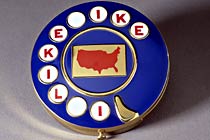Smithsonian Curators to Collect 2012 Political Convention Memorabilia
Wielding large portfolios under their arms, Political History Curators Larry Bird and Harry Rubenstein of the Smithsonian’s National Museum of American History will wind their way through the crowds at the Republican and Democratic National Conventions, not to find a better vantage, but to scout out the best political memorabilia. Since the late 1980s, the duo have been attending party primaries and conventions to collect signs, buttons, posters, hats, sunglasses and other novelties for the museum. It is just one step in the ongoing effort to preserve materials for future generations to study the American political movements.
Every four years “Harry and Larry,” as they are known, attend both conventions to speak with delegates, volunteers, vendors, supporters and protestors about the ways they personally engage in the political process. The curators’ goal is to bring back material that speaks to the atmosphere of the conventions. Their collecting forms part of a large research collection in American presidential politics, and the objects are used to tell campaign stories in museum exhibitions such as “The American Presidency” and “The First Ladies.”
Through their longtime collecting, Rubenstein and Bird have achieved notable national recognition for their collecting at both major party conventions, the Iowa caucus and New Hampshire primaries, and have appeared on national news shows.
“By actively collecting various pieces from the conventions, whether it’s mass generated or self-made, we can document the larger democratic process of America and learn how people personally engage with this process,” Rubenstein said.
During the conventions, the two curators look to collect memorabilia from various parts of the process and from a variety of people. The collection allows researchers and visitors to study and compare how each election season brings new materials, trends and strategies to the political forefront.
“Politics isn’t just what happens up on the podium,” said Bird. “It’s also what happens on the convention floor, outside the building and at vendors’ stalls. These objects give a texture and a feel to the convention.” Putting their own political ideologies aside, the curators aim to collect from both parties equally. As a tradition, they make sure to pick up some of the red, white and blue confetti that inevitably accompanies the end of both conventions.
Today, the museum’s political history collection includes objects related to presidential history and political campaigning, as well as the history of the White House and first ladies; the civil rights, women’s suffrage and reform movements; the World War II home front; and labor history. The political history collection includes some important national treasures, such as the portable desk on which Thomas Jefferson wrote the Declaration of Independence, the top hat Abraham Lincoln wore the night he was assassinated and small metal buttons made to celebrate George Washington’s inauguration in 1789.
The National Museum of American History collects, preserves and displays American heritage in the areas of social, political, cultural, scientific and military history. For information about the museum, please visit http://americanhistory.si.edu or call Smithsonian Information at (202) 633-1000.
Note to editors: Bird and Rubenstein will be available to speak about issues related to the history of the political campaign process and its place within the larger context of the institution of the American presidency. Please call the museum’s Office of Public Affairs at (202) 633-3129 to schedule an interview.
# # #
SI-375-2012
Melinda Machado
202-633-3129

